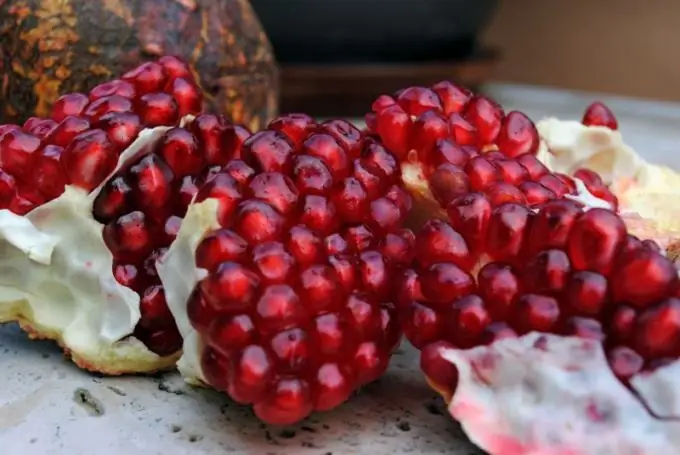- Author Nora Macey [email protected].
- Public 2023-12-16 10:17.
- Last modified 2025-01-23 08:48.
Known for its nutritious and healing fruits, pomegranate thrives best in subtropical climates. However, in central Russia, enterprising plant breeders successfully grow this exotic as a home plant. In an apartment, you can get a decorative bush with orange bell flowers and small fruits. Seeds are often used for breeding pomegranates, since they are distinguished by good germination.

Necessary
- - pomegranate seeds;
- - a container with clean water;
- - shallow container;
- - polyethylene or glass sheet;
- - watering can;
- - pots with a diameter of 8 cm;
- - a mixture of peat and sand;
- - universal flower soil;
- - thermometer;
- - fluorescent or energy-saving lamps (25 watts).
Instructions
Step 1
Prepare planting material. It is recommended to do this in November, although some amateur plant breeders successfully plant exotics at the end of February and the first decade of March. To grow indoor pomegranate quickly, it is recommended to get the seeds of the same house plant. They are already adapted to the conditions of the house and are particularly unpretentious.
Step 2
If you do not have indoor pomegranate fruits, select the grains from the ripe and large purchased specimens. Do not let them dry out, otherwise they will lose their germination. You can soak the seeds for 2-3 days before planting and change the water regularly.
Step 3
Take a shallow container and fill it with light, nutritious soil. The optimal substrate is a mixture of peat and sand.
Step 4
Moisten the soil and bury each grain to a depth of about 1.5 cm. Planting can be done frequently. Cover them with plastic wrap or a sheet of glass to create a greenhouse effect. The container must be installed in a warm room (the optimum temperature is from 25 to 30 degrees).
Step 5
Wait for the first shoots to appear. Pomegranate seeds sprout in different ways - some after a couple of weeks, and sometimes they "sleep" up to 2-6 months. When the seedling releases several leaves, a transplant will be required.
Step 6
Plant the largest, healthiest specimens in individual pots, at least 8 cm in diameter. Use fresh, all-purpose, store-bought flower pot that is great for growing young indoor plants.
Step 7
Water the pomegranate seedlings as the soil dries up, and especially abundantly at high temperatures. If seedlings appear in the fall, it is advisable to organize additional illumination of young shoots with a fluorescent lamp or energy-saving lamps with a power of 25 watts.
Step 8
You can wait for the first flowering of a pomegranate at about 8-10 months of a houseplant's life. Don't expect tall, deciduous shrubs to grow at home. But with good care, over time, you can get a beautiful fruiting exotic up to half a meter high.






